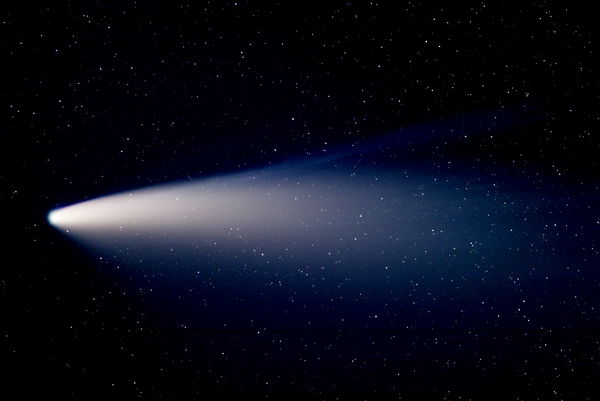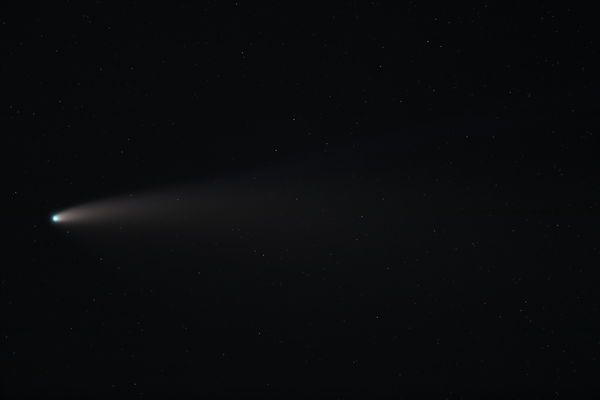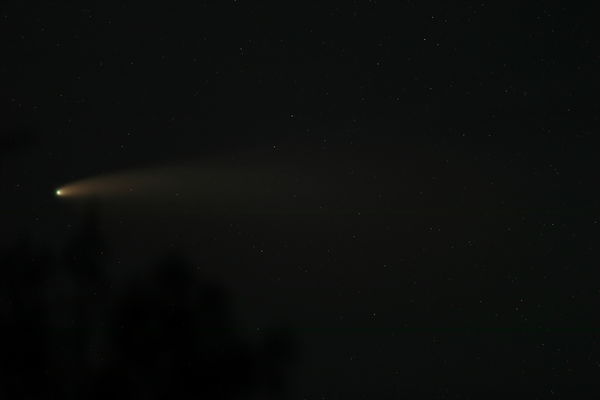Close up of comet Neowise
Jul 17, 2020 19:45:11 #
Ballard
Loc: Grass Valley, California
Last night I took a number of guided shots of comet Neowise with a 500mm telephoto lens. Each image used for stacking was a 30 second exposure with the ISO set to 800. Since the comet was moving relative to the background stars, I first made an image of just the comet by subtracting out the stars and aligning and stacking the comet only. I then took the same images and subtracted out the comet and aligned and stacked only the stars. The first image below shows the result of combining the two stacked images to produce an picture that doesn't show trailing in either the comet or the stars. The next image shows the first frame taken at 10:14PM, the last image shows the frame taken at 10:59 PM. If you download these images you can see how much the comet moved relative to the background stars in just 45 minutes. The last image was actually 45 seconds long but appears redder and dimmer than the image taken at 10:14PM due to being so much closer to the horizon so we are looking through much more of the earths atmosphere. All questions, comments and suggestions are welcome.
stacked image of Neowise (Made with 18 30 second exposures)

(Download)
30 second unprocessed shot taken a 10:14 PM

(Download)
45 second unprocessed shot taken at 10:59PM (This image wasn't used in the stack but was kept to show the comets motion)

(Download)
Jul 17, 2020 20:14:39 #
Wow! I've never seen one this close. It looks great. The stars are sharp! The colors in #3 are amazing.
Jul 17, 2020 20:15:02 #
Ballard wrote:
Last night I took a number of guided shots of come... (show quote)
Whew, what you did Ballard is as far over my head as the comet. I think the images are awesome and thank you for sharing.
Jul 17, 2020 20:24:03 #
Ballard
Loc: Grass Valley, California
Fotoartist wrote:
Wow! I've never seen one this close. It looks great. The stars are sharp! The colors in #3 are amazing.
Hi Fotoartist
Thanks for checking out the image. This is the first time I tried out this new technique of stacking the comet and the stars separately to and recombining them to remove trailing in both the stars and the comet.
Jul 17, 2020 20:25:50 #
Ballard
Loc: Grass Valley, California
Bluefish wrote:
Whew, what you did Ballard is as far over my head as the comet. I think the images are awesome and thank you for sharing.
Hi Bluefish
Thanks for checking out the image. I spent today experimenting with this new method of stacking the stars and comet separately. Looks like it worked.
Jul 17, 2020 20:29:31 #
I’m surprised it fits in a 500mm lens. Nice job on it.
What did you stack it in? if I recall DSS will stack 1) comet 2) stars pr 3) both.
What did you stack it in? if I recall DSS will stack 1) comet 2) stars pr 3) both.
Jul 17, 2020 20:36:50 #
Ballard
Loc: Grass Valley, California
Europa wrote:
I’m surprised it fits in a 500mm lens. Nice job on it.
Hi Europa
Thanks for checking out the image. The tail does actually extend well beyond the edge of the frame, I just didn't stretch the image to get the tail off the end of the frame much. I'll probably give it another go with a shorter focal length to see just how much tail I can get (taken out of context that probably sounded kinda wrong).
Jul 17, 2020 20:44:15 #
Jul 17, 2020 20:47:23 #
Ballard
Loc: Grass Valley, California
alberio wrote:
Ballard, you get the prize. Excellent processing and capture.
Hi Alberio
Thanks for checking out the photo. This comet gave me a chance to try out an learn some new processing techniques to keep the stars and the comet from trailing any.
Jul 17, 2020 20:52:51 #
IDguy
Loc: Idaho
Awesome image! I love how your method kept the stars sharp.
I viewed it the last two nights under very dark sky at high elevation in Idaho. It was dim and viewable best with averted image.
I’m going to photo it tonight from home. Lower elevation (3,400) and less dark sky (Boise about 15 mi, but fortunately in opposite direction). Good news is today’s clouds are clearing.
I’ll go with higher ISO vs stacking. I can go ISO 20,000 plus with my Z6 and think noise reduction on this image isn’t a problem.
I have the Nikon 200-500 but think I’ll first try 70-300. I’d like to get as much tail as possible.
I viewed it the last two nights under very dark sky at high elevation in Idaho. It was dim and viewable best with averted image.
I’m going to photo it tonight from home. Lower elevation (3,400) and less dark sky (Boise about 15 mi, but fortunately in opposite direction). Good news is today’s clouds are clearing.
I’ll go with higher ISO vs stacking. I can go ISO 20,000 plus with my Z6 and think noise reduction on this image isn’t a problem.
I have the Nikon 200-500 but think I’ll first try 70-300. I’d like to get as much tail as possible.
Jul 17, 2020 21:40:57 #
Jul 17, 2020 21:43:22 #
Ballard wrote:
Hi Europa
Thanks for checking out the image. The tail does actually extend well beyond the edge of the frame, I just didn't stretch the image to get the tail off the end of the frame much. I'll probably give it another go with a shorter focal length to see just how much tail I can get (taken out of context that probably sounded kinda wrong).
Thanks for checking out the image. The tail does actually extend well beyond the edge of the frame, I just didn't stretch the image to get the tail off the end of the frame much. I'll probably give it another go with a shorter focal length to see just how much tail I can get (taken out of context that probably sounded kinda wrong).
😂🤣😂🤣
Jul 17, 2020 22:58:50 #
Ballard
Loc: Grass Valley, California
IDguy wrote:
Awesome image! I love how your method kept the sta... (show quote)
Hi IDguy
Sounds like you have a good location. I'm at 2500 ft in the Sierra foothills with Sacramento 50miles south so its not to bad. Averted vision made to tail visible but binoculars made it easy to see.
Jul 17, 2020 23:01:11 #
Ballard
Loc: Grass Valley, California
RodM wrote:
Amazing technique, thanks for sharing.
Hi RodM
Thanks for checking out the photo. Next time all also try and drizzel the image a bit and see if that helps remove some of the noise.
Jul 17, 2020 23:08:05 #
IDguy
Loc: Idaho
Ballard wrote:
Hi RodM
Thanks for checking out the photo. Next time all also try and drizzel the image a bit and see if that helps remove some of the noise.
Thanks for checking out the photo. Next time all also try and drizzel the image a bit and see if that helps remove some of the noise.
What does drizzel mean?
If you want to reply, then register here. Registration is free and your account is created instantly, so you can post right away.




